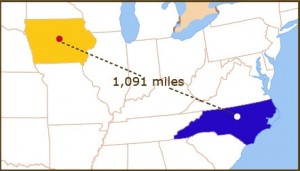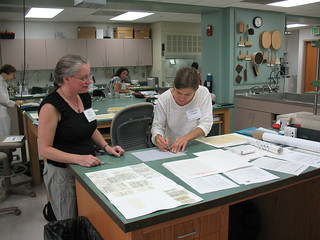 This month on 1091 we take you to Iowa State University Libraries to the home of Parks Library Preservation! In July both Melissa and I had the opportunity to take a master class in conserving transparent paper with Hildegard Homburger, a conservator in private practice in Berlin, Germany.
This month on 1091 we take you to Iowa State University Libraries to the home of Parks Library Preservation! In July both Melissa and I had the opportunity to take a master class in conserving transparent paper with Hildegard Homburger, a conservator in private practice in Berlin, Germany.
Presented by the Friends of the American Institute for Conservation and hosted by Iowa State University Libraries Preservation Department, this class brought together a mix of mid-career and advanced paper and book conservators from museums, libraries and private practice. The sessions combined lecture and hands-on instruction and allowed plenty of time for practice and asking questions.

Hildegard is an expert at conserving these materials and is a generous instructor. On day one we covered the history and manufacture of transparent papers including its unique chemistry. In the practical session we learned to mend tears and losses with aqueous adhesives and how to humidify, dry and flatten these papers to minimize distortion. I think we are all converts to the hard-soft sandwich! On day two we learned mending with synthetic adhesives, how to dye mending papers and how to line fragile transparent papers with Japanese tissue.
During the sessions Hildegard shared not only tips and techniques, but discussed previous projects and how she would do them differently now compared to several years ago. That very much impressed me. We all continue to learn throughout our careers, and it’s easy to forget that what we know now is a result of years of practice and evolving knowledge. Sharing her experiences, and walking us step-by-step through her thought process helped broaden our understanding of how to approach these papers in particular as well as our work in the larger sense.
I tend to think of transparent papers as being mainly architectural tracings, but artists have used transparent papers for printmaking and drawing, and I have seen similar papers in medical flap books and 19th century copy books. Because of its manufacturing process, transparent paper can be tricky to work with. It is very thin, often brittle, very reactive to moisture, and of course transparent so you don’t want to use repair techniques that would make it opaque. I now feel much more comfortable and capable of working with the transparent papers in our collections.

For more images from the workshop check out the Iowa group’s Flickr page. The Smithsonian also hosted two sessions of this workshop and Nora Lockshin has posted about their sessions. Tahe Zalal attended the second session at Iowa State and posted photos.
Don’t forget to head over to Parks Library Preservation to read about Melissa’s experience. Thanks to Hildegard, AIC, Iowa State University and all the participants for making this a wonderful experience.

